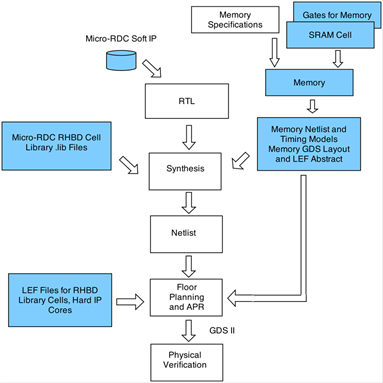
Microelectronics Research Development Corporation
Temporal LatchTM and MICETM Enabled SEU Immune RHBD 90nm CMOS Standard Cell Library
Micro-RDC developed a comprehensive Radiation Hardened by Design (RHBD) cell library for ASIC design using the IBM 9LP 90nm CMOS Process.
Micro-RDC’s RHBD designs include the following technologies to provide electronic integrated circuits with radiation hardening for digital logic architecture, ensuring robust, reliable performance:
Temporal Latch Technology for SEU Immunity- The Cell Library incorporates Micro-RDC's patented Temporal Latch technology for SEU immunity for synchronous designs up to 125 MHz with support for both synchronous and asynchronous resets.
- For clock frequencies up to a GHz, cells are provided using Micro-RDC's patented MICE technology for immunity to SEU and SET. Designers can tradeoff area/power and speed by selecting the correct cells for the desired radiation hardness. For a description of MICE technology see the presentation "Multiply-Interlocked Cell Digital Logic Architecture for SEU and SET Immunity" in the 2012 SEE Symposium.

For further information on Micro-RDC Temporal Latch and MICE technology to mitigate SEU and SET see the following:
1- Mavis, D.G. and Eaton, P.H., “Temporally Redundant Latch for Preventing Single Event Disruptions in Sequential Integrated Circuits”, United States Patent Number 6,127,864, October 2000.
2- Mavis, D.G. and Eaton, P.H., “SEU and SET Modeling and Mitigation in Deep Submicron Technologies”, Proceedings of the International Reliability Symposium (IRPS) pp. 293-305, 2007.
3- Paul Eaton, "Multiply-Interlocked Cell Digital Logic Architecture for SEU and SET Immunity", 2012 SEE Symposium, San Diego.
1- Mavis, D.G. and Eaton, P.H., “Temporally Redundant Latch for Preventing Single Event Disruptions in Sequential Integrated Circuits”, United States Patent Number 6,127,864, October 2000.
2- Mavis, D.G. and Eaton, P.H., “SEU and SET Modeling and Mitigation in Deep Submicron Technologies”, Proceedings of the International Reliability Symposium (IRPS) pp. 293-305, 2007.
3- Paul Eaton, "Multiply-Interlocked Cell Digital Logic Architecture for SEU and SET Immunity", 2012 SEE Symposium, San Diego.
Contact Micro-RDC for a complete list of existing library functions and new developments on more advanced process nodes.
Acknowledgements
In addition to the extensive work done by Micro-RDC in the development of the RHBD Cell Library, Micro-RDC acknowledges DTRA and NASA for their support in advancing the RHBD Cell Library development.
In addition to the extensive work done by Micro-RDC in the development of the RHBD Cell Library, Micro-RDC acknowledges DTRA and NASA for their support in advancing the RHBD Cell Library development.

